On the phonics course that I run, one of the favourite activities has always been using washing lines to teach phonics. Many children love washing lines, and the practitioners like them too. They are easy to create and inspire lots of valuable learning.
Using washing lines in general is great for children. It develops their motor skills, their communication abilities, and is just very adaptable for a range of purposes.
But how can you use washing lines for phonics? You can create a blending line to teach simple reading of two and three letter words. You can also extend this to pegging up a sequence of words and reading simple phrases and sentences.
Phonic skills such as rhyme can be covered by pegging up rhyming objects or pictures.
Read on to find out all about the many and varied activities you can engage with that use washing lines to teach phonics.
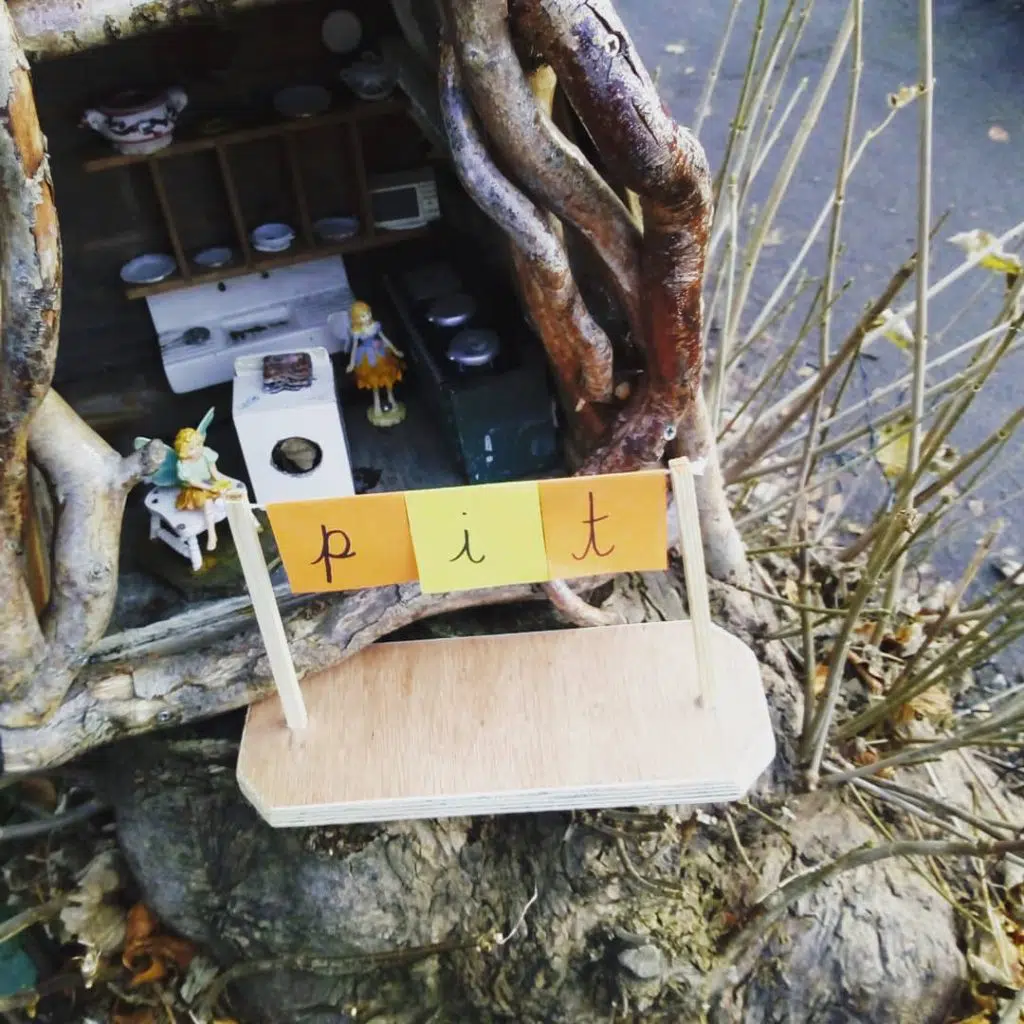
Blending Lines
A blending line is simply a small washing line that is specifically used to help ‘blending’ simple words, usually of two or three letters. Any piece of string stuck between two walls or two tables would work. I like to use mini washing lines, most of which were made by a fantastic caretaker at a school I worked in, but these are certainly not obligatory.
Blending lines are a fantastic tool to begin the process of getting children reading. They are best used when children are at least beginning to orally blend, and when they know a few sounds as well.
Blending is merging together the phonemes you sound out to make a word. For example, you sound out ‘p-e-g’, and then ‘blend’ it to make the word ‘peg.’ For an in-depth description of what blending is and how to teach it, then check out this article.
You can peg sounds up onto washing lines, but my favourite way is to use pieces of card that are bent over in an upside ‘v’ shape with sounds written on them. They are far easier to move quickly, and so either yourself or your children can more speedily make words without the need for thinking too much about the pegging side of things.
It can often make sense to start with two letter words, such as ‘it’, ‘in’ and ‘at.’
You can also make simple words using the first few sounds the children have learned, usually s,a,t,p,i, and n. Examples of words would be things like ‘sit’, ‘tap’, ‘pat’ and ‘tin.’
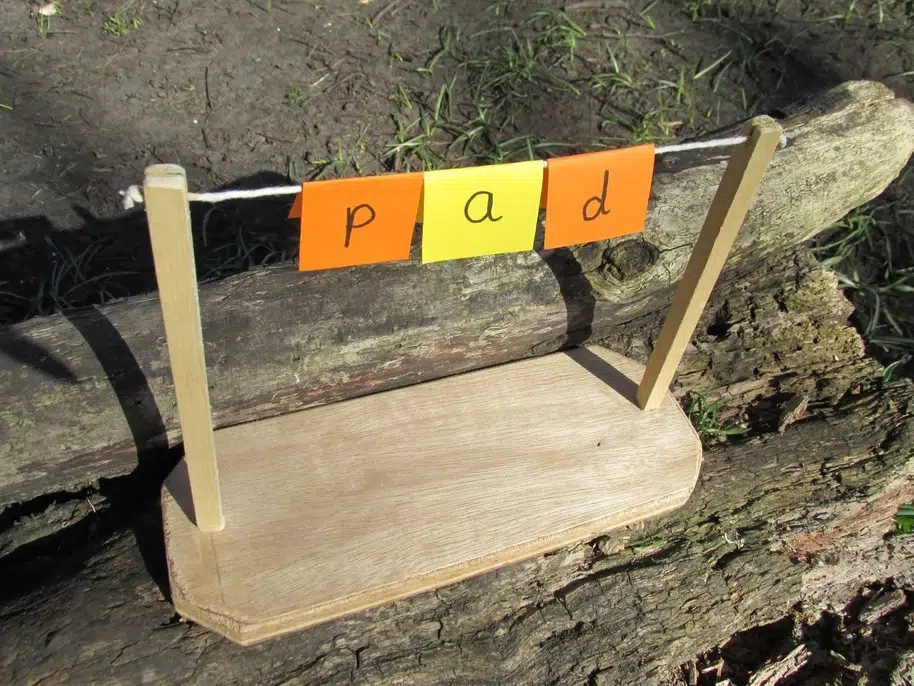
Blending lines are probably best used in an adult-led context to begin with. However, they can also be used very effectively in continuous provision when children have learned how to use them.
How To Make Your Own Blending Line
If you are going to go all-out and make your own, then I don’t think you will be disappointed. You are about to make a fantastic resource that can be used for many years, and is great for a range of storytelling, literacy, math and fine motor activities (you can check out 20 brilliant washing line math activities here).
The simplest way is to get a piece of wood and drill two holes into it. Then superglue two pieces of wood upright in the holes. You can use dowel for thinner lines, or something like cut up broom handles would be brilliant for slightly larger lines.
I would recommend using broom handles, and then the washing lines are more or less unbreakable.
When you have got the simple structure in place, simply attach a piece of string along the top of the blending line. You can drill or saw a hole, or tie or glue it on.
Blending lines come in all different sizes, so try experimenting with different ones.
The favourite ones I have ever used were about 18 inches long.
Sentences On A Washing Line
When children are able to read a few words, the next step is to read simple captions. Once again the blending line is great for this.
Have a selection of simple CVC words that can make sentences. Children can experiment and see if they can make phrases that make sense. Or they can match ideas that the adult has written on a challenge card and see if they can then read them.
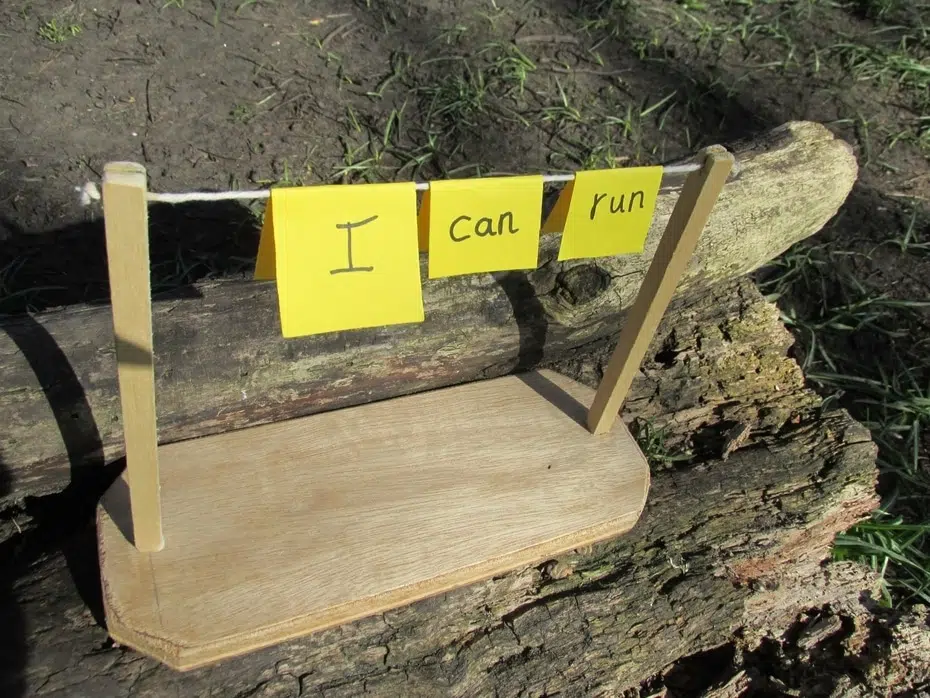
You can match sentences to pictures.
If you use some blank cards then the children can write their own. This can be quite an addictive child-led writing game.
First Sound Game
This game is simpler and can be a precursor to using a blending line.
Have a target sound e.g. ‘s’. Can the children put things that start with that sound on the line?
You could also have a jumbled-up pile of objects or clothes. Some clothes start with the sound and some don’t. Can you find the ones that start with that sound and hang them on the line?
This game can also be used with pictures.
Rhyming Words
There are lots of different rhyming games you can play on a washing line. You could:
- Have a selection of pictures (or objects potentially if they are things that are peggable). You could have a mat, a bat and cat, for example, and maybe a dog, frog and log. Have two sets of rhymes. Try to peg up just one of the rhymes, e.g. everything that rhymes with ‘frog’.
- Draw things that rhyme on pieces of card and peg them up!
- Have words – some that rhyme and some that don’t. Peg up the ones that rhyme! This is the harder next step from pictures.
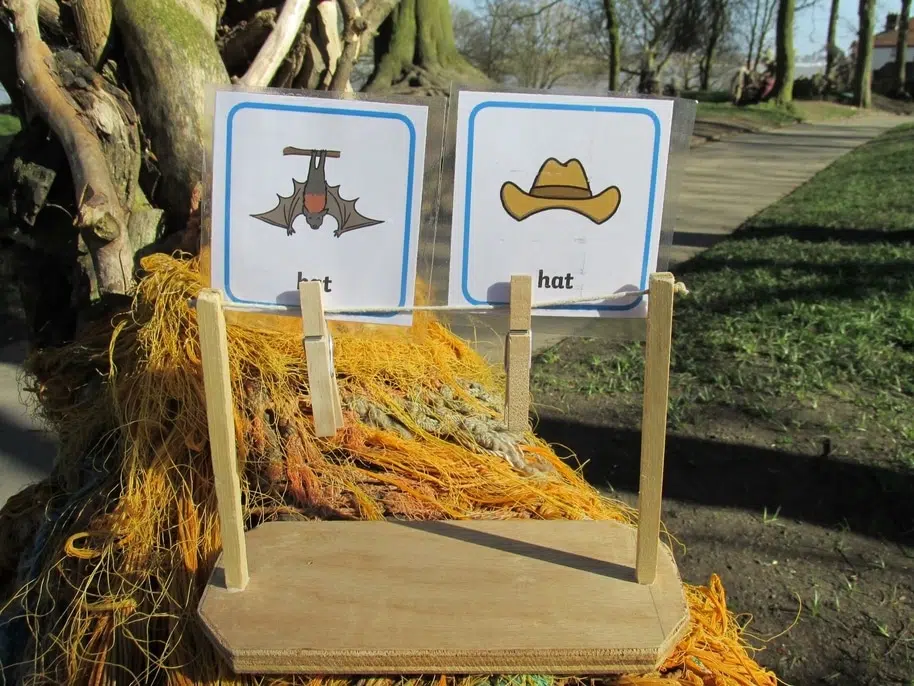
A word of warning about rhyme! It is not as easy as it looks and some children just seem to get the concept better than others. Be positive!
Rhyming Book Pictures
This is probably my favourite way of integrating rhyme into washing lines.
It works really well with some books that have rhyming pairs of objects – The Smartest Giant in Town is a fantastic example of this.
Have pictures of things that rhyme from the book – for example a mouse and a house, or a dog and a bog.
The job is just to simply hand rhyming pairs of pictures next to each other.
Words Substitute
This is quite a well-known simple reading game. You have some simple words that when combined form sentences. If you can have some pictures that match with some of the possible sentences then that is a good thing.
For slightly less able children you can write possible sentences on a challenge sheet. All they need to do then is try to match them, even if they can’t read the words.
Sentences can be simple things like ‘I can hop’, or ‘I can jump’, or ‘I can sing’. Simply changing the last words makes lots of possible combinations.
Pegging Objects And Writing A List
In this activity the children find things to peg up on the washing line. When they have done that, they try to write a list using their phonic skills.
There could be a little story attached to this activity, for example, they need to find things that Baby Bear can take with him to the moon.
Pegging up clothes and labelling them is another fun job.
Outdoor Phonics On Washing Lines
The beauty of using washing lines outside is that you can create massive ones! Literally just a string or piece of rope strung between two fences is all you need. For safety it is good against a wall or fence, or if it is in the middle of a space, put it higher than the head of the tallest child. Otherwise someone will almost certainly run into it.
Outside phonics games for a washing line include:
- Pegging up objects you find. Write a list on the floor in chalk
- Making words using big phonic floor tiles and large outdoor pegs
- Pegging up objects with the word written on cards pegged up next to it
If you are looking for more outdoor phonics games, then take a look at these fantastic outside phonics parachute activities.
Displaying Sounds On A Washing Line
Though I wouldn’t have too many washing lines in a classroom, a couple of carefully selected lines can really have a positive impact as a display tool. They are great as number lines, or also for displaying phonemes or words.
A phoneme is quite simply a sound. For more information about what phonemes are, then take a look at this.
It is good for there to be something for the children to refer too always in the classroom when thinking about sounds or high-frequency words. It builds their independence and allows them to attempt child-led writing.
You can also have big whole-class washing lines for creating words or sentences. This introduces them to the concept and models how to use them.
Large-Scale Washing Lines
Why not have a go at creating giant washing lines for the children to use?
Below is a picture of the incredible long washing line that was created at Layton Primary School in Blackpool.
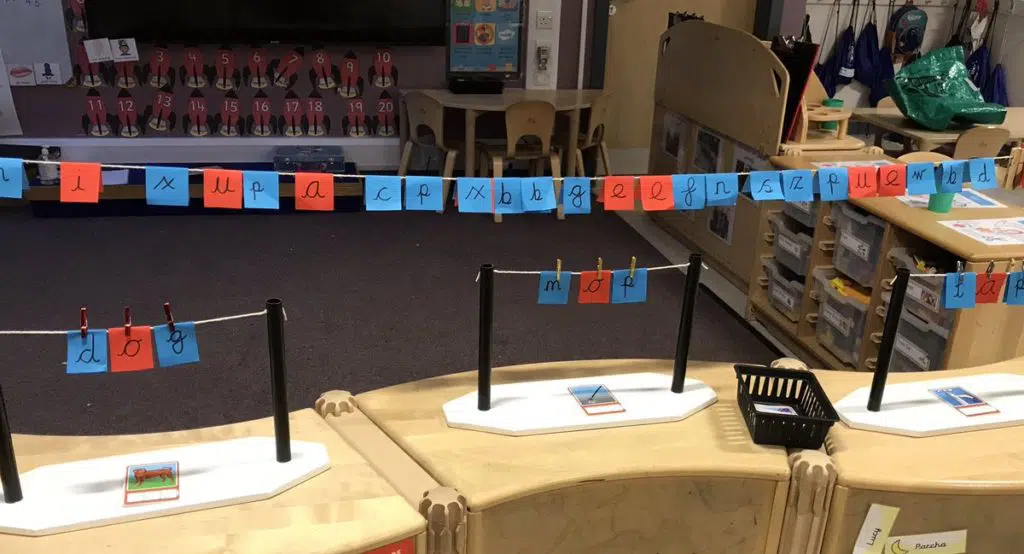
Such a line has a fantastic visual appeal, as well as being really versatile in its uses. It is great as a means for a teacher to demonstrate skills, as well as for multiple children to attempt activities on the same single line.
Big lines also lend themselves well to big items being put on. Massive painted letters would be a fun activity, or chunks of wood with sounds or words written on.
Large lines also promote collaboration. Children working as a team on a project usually results in a wider range of skills being learned.
Improvise!
There are different simple tools that you could use for homemade washing lines.
One of these is the mini clothes maidens that you hang washing upon on a radiator. Simply place one of these on a table, and you have a ready-made washing line that is ready to go.
You can create washing lines by putting string across the alcoves in shelves.
Other ideas could be an open shoe-box with a string across the top. Or a basket, again with string across the top. Just see what you can come up with, if DIY is not for you or anyone you know.
Using Different Items On A Line
Sounds and words don’t have to be written on paper or card. Sometimes loose parts with phonics on make the activity much more engaging.
You can write sounds on pegs, and then peg them straight onto the line.
You could write on leaves and peg them up, or lolly sticks, or wood slices. Anything that is peggable!
The added challenge of pegging something like a lolly stick onto a washing line has an element of challenge that some children like.
Also the randomness of it fires their imagination.
They could look for items themselves around the setting, and use these to create words and sentences.
Adding Depth To Sentences
For older children, the washing lines are really effective at extending sentences.
For example, they may start with something simple like ‘The cat is black.’
Adding a few words can turn this into ‘The old cat is black and thin.’ You can keep adding words and making the sentence more and more complex.
This starts the process of revising sentences, and of redrafting their writing. It is simpler to take words off a line, or add new ones, as opposed to rewriting a sentence or crossing words out.
It is true it would be hard to create a whole paragraph of writing, but in really getting to grips with redrafting a single sentence, this strategy works brilliantly.
Later Strategies
When children are a bit more advanced, there continues to be many things that you can do on washing lines with phonics.
Writing words on cards that contain the same sound but written differently is a great activity. For example, you can write ‘ai’ words.
Some example word cards could be ‘pain’, ‘whale’, and ‘hay’.
You could write rhyming couplets of words and peg them next to each other.
Simple activities involving writing either a simple sentence or just a few words are brilliant for washing lines. Examples of this could be:
Writing metaphors
Writing similes
Rhyming couplets
Haikus
Limericks
Short poems
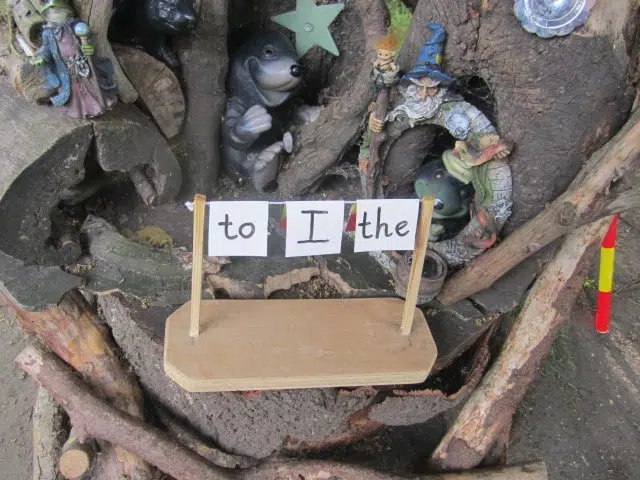
Related Questions
How can you use a washing line for maths? Washing lines are one of the best ways of teaching maths. You can peg up the giant’s clothes and the children’s and compare the two. You can order numbers, or explore missing number problems. You can use pieces of card to explore addition, subtraction and creating patterns.
How can you use a washing line for storytelling? This is another excellent use of washing lines. If you have a sequence of pictures from a well-known story, the children can put them in the right order and talk about what they have created. They can also peg story pictures onto a line and create their own stories. Objects and props that link to a story can also be simply pegged onto a line to spark debate.
Conclusion
Washing lines are a fantastic phonic resource for teaching a range of strategies in both an adult-led and more child-led contexts.
Washing lines are very simple to build or set up, but once you have them then they are a resource that will last for years.
All you need is a piece of string and you are away! Children instinctively enjoy pegging things onto lines, and it really helps them to focus.
You can peg up sounds, words, objects, and you can do it on tiny washing lines or lines as long as your outside area. Good luck with the washing line phonics!
READ MORE
